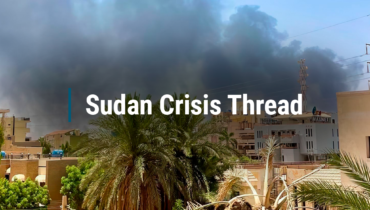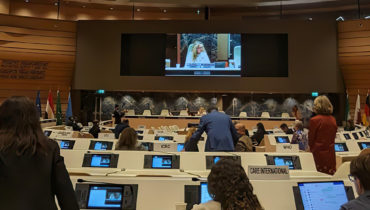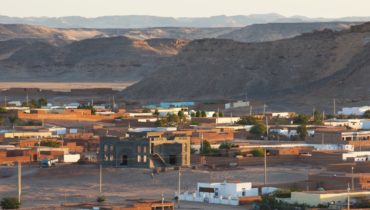Sudan conflict – Intensifying violence, systems collapse, and surging humanitarian needs
12 February 2024
The release of the 2024 Sudan Humanitarian and refugee response plan last Wednesday underscores the critical situation in the country. As Sudan nears 10 months since the conflict began, ongoing violence has significantly increased humanitarian needs and pushed essential systems to the verge of collapse.
| We are about to hit a 10-month mark within a week, I think of the war. Sudan has hugely lost media attention, and this has been very, very difficult indeed. – Martin Griffiths, Under-Secretary-General for Humanitarian Affairs Grandi following the joint launch of the 2024 Humanitarian Needs and Response Plan for Sudan and the Regional Refugee Response Plan. |
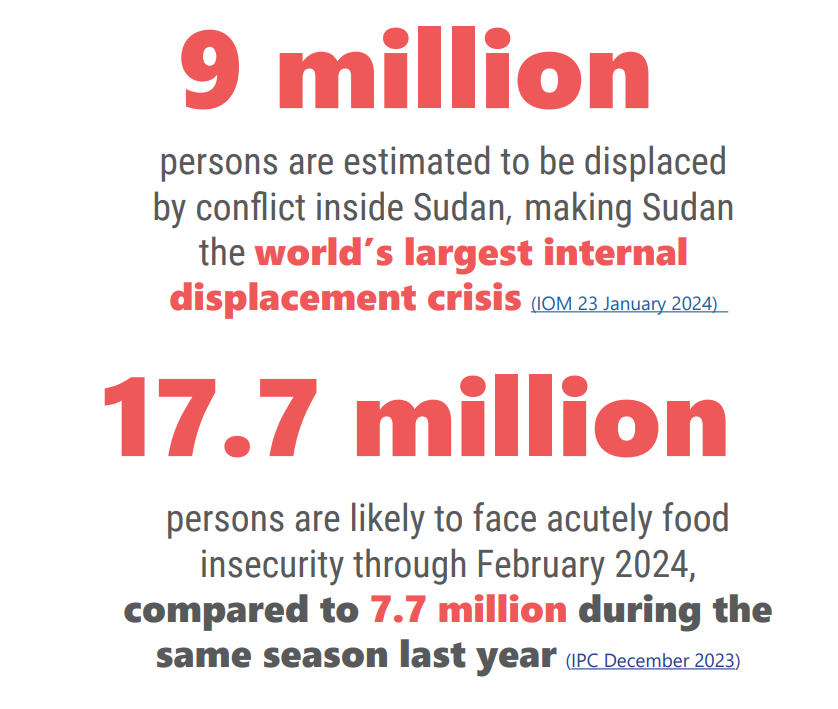 Escalating conflict, including recent clashes reaching Wad Madani, has sparked a mass displacement within Sudan. Over half a million people fled from Wad Madani in just three weeks, pushing the nation’s already high displacement figures to unprecedented levels. These figures mark Sudan as the world’s largest internal displacement crisis, and the trend shows no sign of slowing. To support ongoing discussions at global level in line with the release of the HNRP, IMPACT published a brief summarizing the humanitarian needs and the impacts of the conflicts.
Escalating conflict, including recent clashes reaching Wad Madani, has sparked a mass displacement within Sudan. Over half a million people fled from Wad Madani in just three weeks, pushing the nation’s already high displacement figures to unprecedented levels. These figures mark Sudan as the world’s largest internal displacement crisis, and the trend shows no sign of slowing. To support ongoing discussions at global level in line with the release of the HNRP, IMPACT published a brief summarizing the humanitarian needs and the impacts of the conflicts.
While many have been able to flee, findings suggest that people remain trapped in conflict-affected areas, where essential needs and services are on the brink of collapse, forcing many to make the dangerous trade-off between immediate safety and access to basic survival needs. For those who do manage to escape, the humanitarian crisis extends well beyond the frontlines, affecting not only the displaced individuals but also the communities hosting them across Sudan and neighbouring countries. In fact, as the conflict approaches its one-year mark, the local capacity to support displaced people is wearing thin against a backdrop of unprecedented economic decline and the collapse of livelihoods and services.
The continuous spread of violence and the inability to reach a ceasefire or peace agreement paint a worrying picture for Sudan as it heads into 2024. Compounding shocks and dwindling resilience are expected to drive needs even higher, pushing a large portion of the population into severe food insecurity and acute malnutrition, especially as the lean season approaches in May. Additionally, healthcare facilities, already strained, face the threat of escalating disease outbreaks, increasing the immanent risk of preventable loss of life.
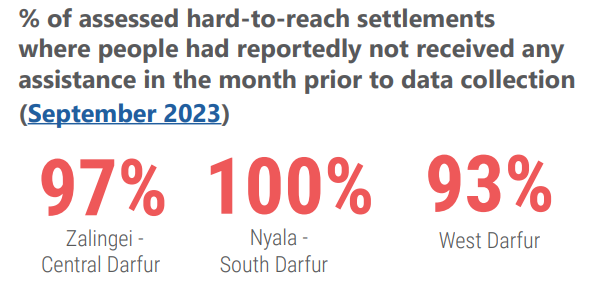 Aid efforts, while increased at the onset of conflict, are still insufficient, reaching only a fraction of those in need. Limited funding, a complex operating environment and bureaucratic and administrative impediments all need to be addressed to deliver assistance to people in need and stave off largescale loss of lives. But beyond this, a more collaborative and flexible way of aid delivery is needed, which includes mechanisms to better support and collaborate with frontline workers, including local respondents. These groups, deeply embedded in communities, have been at the forefront of the response, often operating in areas unreachable by international actors. However, they encounter numerous challenges, ranging from communication barriers, security risks and insufficient resources – highlighting the need for a clear collaborative strategy and increased meaningful support to locally led initiatives.
Aid efforts, while increased at the onset of conflict, are still insufficient, reaching only a fraction of those in need. Limited funding, a complex operating environment and bureaucratic and administrative impediments all need to be addressed to deliver assistance to people in need and stave off largescale loss of lives. But beyond this, a more collaborative and flexible way of aid delivery is needed, which includes mechanisms to better support and collaborate with frontline workers, including local respondents. These groups, deeply embedded in communities, have been at the forefront of the response, often operating in areas unreachable by international actors. However, they encounter numerous challenges, ranging from communication barriers, security risks and insufficient resources – highlighting the need for a clear collaborative strategy and increased meaningful support to locally led initiatives.
| The onset of the conflict, less than a year ago, has catapulted Sudan into a countrywide humanitarian emergency. Yet considering the increasingly complex operating environment, there’s a clear need for real-time monitoring and response to enable innovative and effective ways of delivering humanitarian aid to those who need it most. If the current situation endures and the response remains curtailed, Sudan risks turning into a forgotten crisis of catastrophic dimensions. – Nanki Chawla, Global Emergencies Unit Manager |
In 2023, Sudan’s response plan fell short of half of its required funding to address humanitarian needs. This year, it is crucial to scale-up the response, including strong advocacy for better access and increased funding, to prevent widespread loss of life and to ensure that Sudan doesn’t slip into a forgotten crisis.
For a more in-depth analysis of the situation, read the full Sudan brief.


